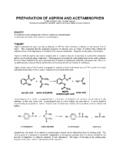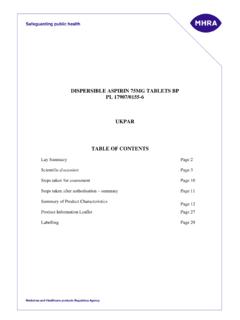Transcription of Synthesis and Analysis of Acetyl Salicylic Acid - Josh …
1 Chan 0 Synthesis and Analysis of Acetyl Salicylic acid Amy Chan CHEM 290 - Section 1 November 25, 2002 Chan 1 Introduction Acetyl Salicylic acid , commonly known as aspirin , is one of the most common synthetic medicines. First discovered in 1897 by Felix Hoffman, it has since been used in over 50 over-the-counter medicines. aspirin is primarily used to treat pain as well as to avert cardiovascular disease. The purpose of this lab is to synthesize and characterize high purity aspirin . The aspirin synthesized in this experiment will be crystallized from solution. Crystallization will be induced by scratching the glass beaker to create nuclei around which aspirin may crystallize.
2 The solution will be formed by combining Salicylic acid with acetic anhydride. aspirin and acetic acid are formed when the hydrogen in the phenolic alcohol group of Salicylic acid is replaced by an Acetyl (H3 CCOO) group. Phosphoric acid is added to catalyze the reaction. The Synthesis reaction is summarized below: Figure 1 Synthesis Reaction for Aspirin1 After the crystals are formed, the percent yield will be calculated before the Analysis is done. In order to determine the purity of the aspirin , it must be characterized through various techniques based on an understanding of the energy of the system on the microscopic and atomic scale.
3 The aspirin will be characterized by three methods: melting point Analysis , Fourier transform infrared spectroscopy (FTIR), and Fourier transform nuclear magnetic resonance spectroscopy (FTNMR). 1 Source: Webpage - #major Chan 2 Experimental Synthesis of aspirin In the first part of the experiment, aspirin was synthesized. A filter crucible and mortar and pestle were obtained from the instructor. Next, g of Salicylic acid were weighed into a 100 mL beaker, which was then covered with a watch glass. This beaker, 2 graduated cylinders, a distilled water wash bottle, medicine dropper, and another beaker of distilled water were brought to the hood.
4 The reaction took place after 9 mL of acetic anhydride and 15 drops of phosphoric acid were added to the reaction beaker under the hood. The hood was used as a safety precaution because of the dangers of using acetic anhydride. The solution was gently heated over a Bunsen burner until it was almost boiling. After removing the heat, the solution was left to cool for three minutes before the slow addition of 45 drops of distilled water from the extra beaker of distilled water using the medicine dropper. The mixture was cooled for several minutes before 30 mL of distilled water were added to the solution.
5 The beaker was swirled to mix the solution well before it was left to cool again. During the time of cooling, an ice water bath was prepared in a 400 mL beaker. The mixture was left to cool until the beaker was comfortable to touch before it was carried back to the lab bench. At the lab bench, the aspirin crystallized out of the solution. Crystallization was induced by scratching the beaker with a metal scoopula. The glass crystals became the nuclei around which aspirin could crystallize. The beaker was placed in an ice water bath immediately after the scratching for a total time of fifteen minutes.
6 After the first five minutes, the beaker was gently swirled for several seconds. During this time, 60 mL of distilled water were chilled in a separate ice bath. When the crystallization was complete, the aspirin crystals needed to be filtered and washed. The crystals were filtered and washed to purify the yield. First, the crystals were poured into the filter crucible. Next, the liquid was pressed out of the crystals with a glass stopper on top of a piece of filter paper. The crystals were then washed three times with the chilled distilled water. The filter crucible was removed from the aspirator and about 20 mL of the chilled water was added.
7 The mixture was stirred for several seconds before the filter crucible was placed over the aspirator. Stirring continued while the liquid solution was being filtered again. These washing steps had to be performed quickly to minimize the loss of aspirin due to its solubility in water. After the three washings, it was observed that one could not smell acetic acid in the crystals. Thus, the crystals were ready to be dried. This was accomplished by drying the undisturbed crystals with the aspirator on for ten minutes. Then, Chan 3 the crystals were lightly stirred in the filter crucible for an addition five minutes with the aspirator on.
8 Lastly, the crystals were spread evenly on a labeled watch glass before they were placed in an over for thirty minutes. The final step of this stage of the experiment was to determine the percent yield of the aspirin . While the crystals were in the oven, a clean, dry vial was appropriately. This vial was weighed on a top load balance, and the mass was recorded. When the crystals were finished drying in the oven, they were removed and ground to a fine powder in the mortar and pestle before being poured into the labeled vial. The vial with the aspirin was weighed and the mass was recorded.
9 This vial was then stored in the dessicooler until the characterization began. Melting Point Characterization The melting point is used to ascertain the temperature at which the kinetic and potential energy of the molecules are equal. However, since melting does not occur at a single temperature, a melting point range is found. This melting range represents the range where the solid aspirin melts into a liquid. In the solid phase, the aspirin is packed to obtain the lowest energy configuration in the lattice. At the melting range, a sufficient amount of energy is added to overcome the hydrogen bonds, dipolar-, electrostatic-, and van der Waals forces that exist in the lattice.
10 These forces also are present in the liquid state, but they are weaker. Purity will be determined based on the values of the melting range: less pure substances will have a lower melting point and a larger melting range. The melting point range was determined using a Thomas-Hoover apparatus. First, the samples were packed into the melting point tube. This was accomplished by pressing the open end of the tube into the sample until the sample was about 2 mm into the tube. The sample was then packed by dropping the tube in a condensor tube, with its closed end down, which minimized the chance of the melting point tube breaking.





